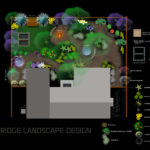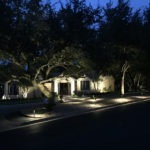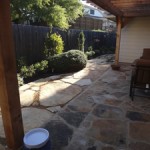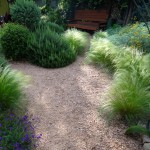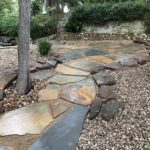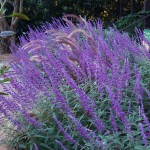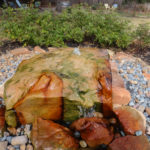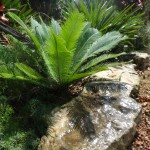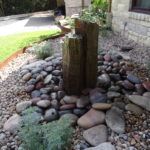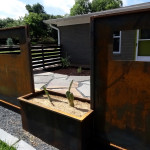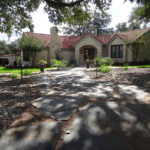Sorry, I meant “Mud Dauber”! (Trypoxylon politum)
“dirt dauber,” “dirt dobber,” “dirt diver”, or “mud wasp” .
The organ-pipe mud dauber, as the name implies,
builds nests in the shape of a cylindrical tube
resembling an organ pipe or pan flute.
This nest I captured was orientated horizontally, but most
pipes are arranged vertically and look just like organ pipes.
(Photo courtesy of Wikipedia).
Organ pipe mud daubers are an exceedingly
docile species of wasp, and quite colorful too.
They also play amazing peruvian music
on their pan flutes.
What amazing mud architects and builders these
Frank Lloyd Wasps (ahem) are. I caught a couple
more “show homes” hiding under the
eaves of this house. More on this house later.
Check out this muddy palace,
a damsel would most definitely be in distress locked up in here.
Can you see the “Thestral” looking down on
you in ESP’s previous mud dauber nest image Harry?
Mud Daubers have a much darker side to their existence…
as a special risk to aircraft operations. They are prone to nest in the
small openings and tubes that compose critical aircraft systems.
(Yes, one more thing to worry about, careering along in a metal tube at
forty thousand feet).
I Quote: “Their presence in these systems can disable or impair
the function of the airspeed indicator, the altimeter, and/or the
vertical speed indicator “… Well nobody tells you that at check-in!
It is thought that mud dauber wasps were ultimately responsible
for the crash of Birgenair Flight 301,
which sadly killed 189 passengers and crew.
One disadvantage to making nests is that most
of the nest-maker’s offspring are concentrated
in one place, making them highly vulnerable to predation.
Once a predator finds a nest, it can plunder it cell by cell.
A variety of parasitic wasps, ranging from extremely tiny
chalcidoid wasps to larger, bright green chrysidid wasps
attack mud-dauber nests.
They pirate provisions and offspring as
food for their own offspring.

Adults of both sexes frequently drink flower nectar,
but they stock their nests with spiders, yes spiders, which serve
as food for the mud-daubers’ offspring.
Like Culinary connoisseurs, they prefer particular kinds of spiders,
and particular sizes of spiders for their larders. Brrrr.
Instead of stocking a nest cell with one or two large spiders,
mud-daubers cram as many as two dozen small
spiders into a nest cell.
What creative little creatures.
Talking of wasps, (and bees)
drinking nectar…
they have recently been going crazy over the blooms on this coral vine…
Antigonon leptopus.
Watch out for this vine though, it is quite the sprawler, it is now considered a
Category II invasive species by the Florida Exotic Pest Plant Council. This one has been
popping up on my neighbors fence-line for years. I usually allow a few vines to creep over my
evergreen wisteria (Milletia reticulata). I have a love/hate relationship with this plant, but
when one blooms like this one, I always think I should allow more to “invade”.

You can see the actual flowers are tiny but the sepals
are larger and provide the brilliant colors that range
from white to rose-pink to deep coral flowered varieties.
Another “colorful” collision took place about three feet above my head.
A loud “thwack” followed by some extremely poor navigation and
uncustomary bad flying skills, had me ducking for cover in my Inland Sea Oats.
It must be really hard to fly with eight wings, all pushing in
multiple directions. It is a wonder how they manage to
maneuver to solid ground at all.
Do they decide who he is going to take the lead?
These two love-birds finally crash-landed on top of this canna lily,

Want to see some really amazing dragonfly photography! …
http://www.birdcrossstitch.com/dragonflies/
Be sure to click on the first image…a stunning emergence sequence.
I thought at this point I would share some local neighborhood horror with you…
The next scene comes with a warning from the
“Don’t ever do things like this” brigade.
A tragic sequence of events led to this sad scene around the corner from my house.
This is a strip of land that borders a parking lot and the sidewalk,
and this is what regretfully happened:
First of all the soil was turned over, then some poor plants were planted.
The dormant bermuda seeds lurking in the soil were quickly
activated and naturally assimilated the newly turned soil…they felt good… and grew.
A work crew was then brought in to “rip” out the now emerging bermuda, but as we know…
..
“Shhhh, you will learn to embrace Bermuda Grass, Locutus of Borg”.
Resistance is futile.
An “optimistic” layer of mulch was placed on top of
the “topically” removed bermuda. Naturally it looked good for about a week.
A couple of weeks later the Borg seeds had emerged and grown above the
mulch, once again engulfing the planting scheme.
A complete disaster.
The only thing to be done here is to rip it all out and start from scratch.
Mulch WILL not stop bermuda grass…EVER!
There is nothing worse than a bed gone awry. Concrete with a couple of
large “Whole Foods” planters would have been a better solution here,
and a lot less expensive.
Hell strips are always an issue though. Even if they are done right with weed
barrier and the ever popular decomposed granite xeriscaping. By the third
year seeds will have blown in, and weeds will have germinated. What to do?
What to do?
Other things baking in the ESP this past week…
The Inland Sea oats have quickly gone into their Autumn coloration,
or are they just pan seared?
But does this vine care?
Due to our extremely mild winter last year, this red passion flower
vine did not die back to the ground as it usually does. It now
threatens to engulf my entire front porch, it is going totally berserk!
This is how it looks after multiple prunings starting in the early
spring, and I have not watered it once,
hence the middle section declining.
On the subject of watering…here is our resident hobbit walking
out into the “Shire” after arriving home from pre-school.

I wonder what has caught his attention?
I can tell you this, it is not the gazing ball …
Completely transfixed…
“m..m..must get to the water stream”.

This foxtail fern Asparagus densiflorus
has started to bloom this week. There seems to be a lot of on-line
confusion about the name of this plant, as the foxtail fern is very
similar to Asparagus Fern only its growth habit is very dense,
and it creates “green tails”.
Foxtail fern is actually not a fern at all, it does not have spores
like a fern but actual seeds. It is a member of the Asparagus
genus, as in the vegetable.
These small white flowers will be followed by bright red berries.

And here is my Asparagus Fern or Emerald Fern or Emerald Feather (top)
sprawling over an old cedar carcass. (Also not a true fern).
Asparagus setaceus / Asparagus plumosus
I used to have this plant climbing up two large bamboo poles drilled,
with wooden dowels pushed into the holes to support the fern as it climbed.
Here they are, some years ago, before I ripped them down:
Wow have things changed somewhat since this picture was taken.

An extremely prolific succulent!
Almost every plantlet from this bryophyllum plant,
no matter the soil conditions, germinates.

Potato Vine…really interesting brown leaf margin – looks like a defining pencil line.

I finally got round to measuring the mammoth giant timber culm …
four inches diameter for anyone remotely interested.
This area seems to be naturally turning into a rounded shrub area – interesting,
because I have an aesthetic problem with almost anything topiary.
I cannot even tolerate commercially pruned boxwoods!
The only rationale I can think of as to how this scene has come to be,
is that the cherry barbados (left) needs to be pruned tight to stop it
interfering with the pathway. The Texas sage shrub (in front of the canna lily)
simply looks bad if left to its own devices – all gangly and such, and the copper
canyon daisy (right) will sprawl out naturally for its fall “show-off” period…
or I am just in topiary denial?
Notice I did not mention the rosemary shrubs.
Stay Tuned For:
“Staring through Windows”
All material © 2009 for east_side_patch. Unauthorized intergalactic reproduction strictly prohibited, and punishable by late (and extremely unpleasant) 14th century planet Earth techniques.
Inspirational Images of the Week:

Designed by Lizzie Taylor and Dawn Isaac RHS Silver Gilt medal winners at Chelsea 2005
from England, this HG Wells looking garden
would be perfect
for…

































